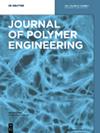Preparation and properties of dynamic crosslinked styrene butadiene rubber
IF 1.7
4区 工程技术
Q4 POLYMER SCIENCE
引用次数: 0
Abstract
Abstract As the second largest synthetic rubber after styrene butadiene rubber, cis-butadiene rubber (BR) is one of the important raw materials for automobile tires and cold-resistant products. Herein, a traditional rubber preparation process was used to introduce dynamic reversible bonds into BR based on an “imitative” click reaction. Compared with traditional complex self-healing techniques, this method is undoubtedly simpler and more efficient. Dynamic reversible bonds are able to break and recombine under the stimulation of external conditions, which endow rubber with self-healing properties. We use the small biological molecule lipoic acid (LA) as a cross-linking agent and cross-link LA and BR through mechanical compounding and hot press vulcanization to obtain self-healing butadiene rubber (BLA). In addition, BLA-(Zn2+) was further prepared by introducing Zn2+ to form metal-oxygen coordination bonds with carboxyl groups. And systematically studied the effect of Zn2+ on the mechanical properties and self-healing properties of cross-linked BR. Through the combined action of disulfide bonds, hydrogen bonds and Zn2+-O coordination bonds, BLA-(Zn2+) has better properties than BLA, the tensile strength can reach 3.76 MPa, and the repair efficiency is about 82 %. This simple preparation process is certainly more cost effective.动态交联丁苯橡胶的制备与性能
摘要顺丁橡胶是仅次于丁苯橡胶的第二大合成橡胶,是汽车轮胎和抗寒产品的重要原料之一。本文采用传统的橡胶制备工艺,在“模拟”点击反应的基础上,将动态可逆键引入BR中。与传统的复杂自修复技术相比,这种方法无疑更简单、更高效。动态可逆键能够在外部条件的刺激下断裂和重组,赋予橡胶自修复性能。我们使用小生物分子硫辛酸(LA)作为交联剂,通过机械复合和热压硫化将LA和BR交联,获得自修复丁二烯橡胶(BLA)。此外,通过引入Zn2+与羧基形成金属-氧配位键,进一步制备了BLA-(Zn2+)。系统研究了Zn2+对交联BR力学性能和自修复性能的影响。通过二硫键、氢键和Zn2+-O配位键的共同作用,BLA-(Zn2+)具有比BLA更好的性能,拉伸强度可达3.76 MPa,修复效率约为82 %. 这种简单的制备过程当然更具成本效益。
本文章由计算机程序翻译,如有差异,请以英文原文为准。
求助全文
约1分钟内获得全文
求助全文
来源期刊

Journal of Polymer Engineering
工程技术-高分子科学
CiteScore
3.20
自引率
5.00%
发文量
95
审稿时长
2.5 months
期刊介绍:
Journal of Polymer Engineering publishes reviews, original basic and applied research contributions as well as recent technological developments in polymer engineering. Polymer engineering is a strongly interdisciplinary field and papers published by the journal may span areas such as polymer physics, polymer processing and engineering of polymer-based materials and their applications. The editors and the publisher are committed to high quality standards and rapid handling of the peer review and publication processes.
 求助内容:
求助内容: 应助结果提醒方式:
应助结果提醒方式:


